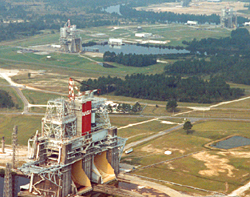
The Rocket Propulsion Test Complex, or the National Space Technology Laboratories, was established in the early 1960s as the national rocket test range for large rocket propulsion systems. This facility in Mississippi was the primary site for conducting research, development and certification testing on non-flight engines to improve and upgrade basic engine design and acceptable testing of flight engines.
The Saturn V rocket was one of the most reliable rockets ever built for the space program and was crucial to the effort to land a man on the moon. The success of the Saturn V was dependent upon extensive ground testing of the vehicle. Once the Saturn V lifted off the pad there was no turning back for repairs. Its powered flight was brief but critical. The economics of rocketry and the physical safety of the astronauts demanded that the rocket work perfectly. This was the purpose of the Rocket Propulsion Test Facility. No Saturn V was shipped to the Kennedy Space Center until its engines were fully tested and certified. Any problem capable of causing a failure in the vehicle was discovered and corrected before the actual launch. The Rocket Propulsion Test Complex was the critical final step in certifying the Saturn V rocket ready for flight.

The two test areas, A and B, of the Rocket Propulsion Test Complex were both built in 1965. The B Test Complex supported all ground testing for the S-1C stage of the Saturn V rocket. Its test stand is a dual position stand, 407 feet tall and constructed from steel and concrete resting on 1600 steel pilings each 98 feet long. During test firings, the S-IC stage was secured by four huge hold-down arms anchored to a slab of concrete 39 feet thick. The retraining arms clamped onto the rocket tail by means of a drive mechanism geared to move only three inches per minute. In addition to the test stand, the B Test Complex consists of a Test Control Center (TCC) and the required technical facilities (water, electrical, high pressure gas, propellant systems, etc.), as well as the associated ground support equipment necessary to control and fire the captive stage. The TCC houses the equipment and people required to control, observe, supervise and monitor the operation of the test complex. The TCC is also a position from which technical observers can view test firings and which provides a blasterproof location for test stand personnel who have vacated the stand during test firings. The TCC is capable of supporting additional stage and/or engine test stands. The high-pressure Gas System includes a battery of air, nitrogen and helium. The propellant system includes a 300,000-gallon ready storage tank and docking and transfer facilities for the liquid propellant barges.

The A Test Complex performed all ground testing for the S-11 stage of the Saturn V rocket. It consists of two single-position test stands, designated A-1 and A-2, a TCC, observation bunkers, technical systems (such as high-pressure gas systems, water, electrical, etc.), as well as all associated ground service equipment necessary to control and fire engines or stages involved. Each stand is capable of static firing a stage up to 33 feet in diameter and 82 feet long. Using an adapter system or modifying the stand can test stages of greater or smaller diameter and length. These stands were designed for 1,000,000 pounds of thrust although they have a capability up to 1,200,000 pounds. The stand propellant systems include liquid oxygen and liquid hydrogen. The TCC performs the same functions as the B TCC. It is also capable of supporting additional test stands without modifying the physical facilities. The high-pressure gas battery contains air, helium and nitrogen. There is also a separate gas battery for the hydrogen system. The A Test Complex now supports engine testing for the Space Shuttle program.
Visit the National Park Service Travel American Aviation to learn more about Aviation related Historic Sites.
Last updated: August 28, 2017
